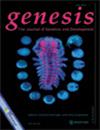果蝇Pc-G基因的小鼠同源物esc在果蝇中发挥显性负作用。
IF 1.5
4区 生物学
Q3 Biochemistry, Genetics and Molecular Biology
引用次数: 0
摘要
在果蝇和哺乳动物中,Polycomb组基因参与维持同源基因的长期转录抑制。小鼠的基因座编码果蝇ESC蛋白高度保守的同源基因。为了测试这两个基因之间的功能守恒,将eed引入果蝇,以确定它是否可以挽救esc突变体的表型。Eed对与esc突变相关的腿转化表型具有显性负向影响。这一结果是根据体外蛋白-蛋白结合数据和体内多烯染色体染色来解释的,表明Eed和果蝇E(Z) (ESC的分子伴侣)之间缺乏显著的相互作用。创世纪26:67- 76,2000本文章由计算机程序翻译,如有差异,请以英文原文为准。
Mouse homolog of the Drosophila Pc-G gene esc exerts a dominant negative effect in Drosophila.
The Polycomb group genes are involved in maintaining long term transcriptional repression of the homeotic genes in both Drosophila and mammals. The mouse eed locus encodes the highly conserved ortholog of the Drosophila ESC protein. To test the functional conservation between the two genes, eed was introduced into the fly to determine whether it could rescue the esc mutant phenotype. eed exerted a dominant negative effect on the leg transformation phenotype associated with the esc mutation. This result is interpreted in light of in vitro protein-protein binding data and in vivo polytene chromosome staining indicating the lack of significant interaction between Eed and fly E(Z), a molecular partner of ESC. genesis 26:67-76, 2000
求助全文
通过发布文献求助,成功后即可免费获取论文全文。
去求助
来源期刊

Genesis
DEVELOPMENTAL BIOLOGY-GENETICS & HEREDITY
CiteScore
3.90
自引率
0.00%
发文量
19
期刊介绍:
As of January 2000, Developmental Genetics was renamed and relaunched as genesis: The Journal of Genetics and Development, with a new scope and Editorial Board. The journal focuses on work that addresses the genetics of development and the fundamental mechanisms of embryological processes in animals and plants. With increased awareness of the interplay between genetics and evolutionary change, particularly during developmental processes, we encourage submission of manuscripts from all ecological niches. The expanded numbers of genomes for which sequencing is being completed will facilitate genetic and genomic examination of developmental issues, even if the model system does not fit the “classical genetic” mold. Therefore, we encourage submission of manuscripts from all species. Other areas of particular interest include: 1) the roles of epigenetics, microRNAs and environment on developmental processes; 2) genome-wide studies; 3) novel imaging techniques for the study of gene expression and cellular function; 4) comparative genetics and genomics and 5) animal models of human genetic and developmental disorders.
genesis presents reviews, full research articles, short research letters, and state-of-the-art technology reports that promote an understanding of the function of genes and the roles they play in complex developmental processes.
 求助内容:
求助内容: 应助结果提醒方式:
应助结果提醒方式:


